Computer Applications | IC3 Certification | Digital Literacy
IC3 Spark vs IC3 GS5 Digital Literacy Certifications: What’s the Difference?
For nearly 10 years, Bri has focused on creating content to address the questions and concerns educators have about teaching classes, preparing students for certifications, and making the most of the iCEV curriculum system.
With the increased focus on industry certifications across all career pathways and courses, computer applications teachers are the latest group of educators feeling the pressure.
While some teachers lean toward the Microsoft Office Specialist certification, many teachers are increasingly looking into the IC3 Digital Literacy Certification.
But when teachers dive a little deeper, they realize there are multiple IC3 certification options available!
To help you navigate the complicated world of IC3 certifications, we’ll discuss the two most common options: IC3 Spark and IC3 GS5.
But before we get into the differences, it’s important to understand the IC3 digital literacy program as a whole!
What Is the IC3 Digital Literacy Certification Program?

The term “IC3” stands for Internet Core Competency Certification. It’s the worldwide benchmark of a student’s understanding of computer-based technology.
The IC3 certifications were developed by Certiport, a subsidiary of the Pearson textbook company. According to Certiport, more than 3 million students in 78 countries have taken an IC3 Digital Literacy certification exam.
One reason so many teachers are choosing IC3 is because Certiport is a well-established certification provider.
In addition, teachers like IC3 because they see two big benefits for their students.
The first benefit is that students who pass the exam receive industry-recognized credentials. Even more importantly, the IC3 program reinforces foundational skills students need for success in school and careers!
So with that in mind, how is the IC3 Digital Literacy program structured?
How Is the IC3 Digital Literacy Program Structured?

Both the IC3 Spark and IC3 GS5 have the same basic structure that covers three distinct computer-related areas.
These areas are:
- Computing Fundamentals
- Living Online
- Key Applications
The Computing Fundamentals portion focuses on the foundational understanding of computing. You’ll find topics such as operating systems, computer hardware, and computer software.
The Key Applications portion focuses on common applications someone will use in daily life. These include common word processing, spreadsheets, and presentation applications.
The Living Online section of the certification covers the skills required for effectively using the Internet. Living Online includes concepts like email communication, digital citizenship, and social media usage.
Though these three sections are found on both the IC3 Spark and IC3 GS5 exams, the level of detail and information vastly differs!
So, let’s start looking at the differences starting with the IC3 Spark certification.
What Is the IC3 Spark Certification?

The IC3 Spark certification is a digital literacy certification designed for younger students who are not familiar with computers, the Internet, and other digital concepts.
As mentioned above, the IC3 Spark exam is made up of Computing Fundamentals, Living Online, and Key Applications. These areas are broken down into 12 subsections, which Certiport refers to as “objective domains.”
The 12 IC3 Spark objective domains are:
- Operating system basics
- Computer hardware and concepts
- Computer software and concepts
- Common application features
- Word processing activities
- Spreadsheet activities
- Presentation activities
- Browsers
- Digital communication
- Digital citizenship
- Safe computing
- Research fluency
Students are tested for their knowledge in these 12 areas when they sit for the IC3 Spark exam. The exam has 45 questions and students are given 50 minutes to complete it.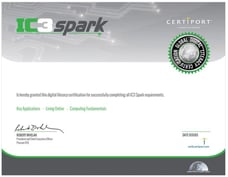
When a student passes the IC3 Spark exam, they receive an IC3 Spark Global Digital Literacy Certificate, which acknowledges their accomplishment.
Overall the IC3 Spark certification is an excellent way for you to measure the knowledge of middle school students.
Now, you may be thinking: I teach high school students!
Luckily, that’s where the IC3 GS5 certification comes into play!
What Is the IC3 GS5 Certification?

The IC3 GS5 certification is a more advanced version of the IC3 Spark certification.
The “GS5” in this title stands for “Global Standard 5,” and it’s the newest version of the advanced IC3 Digital Literacy certification.
Like IC3 Spark, the IC3 GS5 certification is comprised of three topic areas. However, each topic listed in the IC3 GS5 has its own exam!
Here we’ll give you the details on each one, starting with Computing Fundamentals.
The IC3 GS5 Computing Fundamentals Exam
The Computing Fundamentals exam is meant to help students gain a better understanding of how computers process information and the basics of hardware, software, and operating systems.
Overall, the exam is made up of 50 questions that relate to seven subtopics in the computing fundamentals area: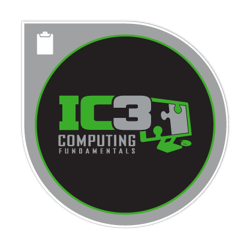
- Backup and restore
- Cloud computing
- Computer software architecture
- File sharing
- Hardware
- Mobile devices
- Security
When a student passes the IC3 GS5 Computing Fundamentals exam, they will receive a digital badge that acknowledges their accomplishments.
The IC3 GS5 Key Applications Exam
The Key Applications exam covers common features found in word processing, spreadsheet, and presentation applications.
The Key Applications exam has 45 questions related to these seven subtopics: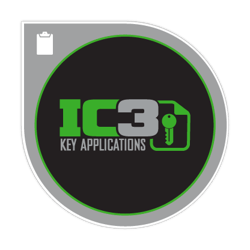
- Common features
- Word processing
- Spreadsheets
- Databases
- Presentations
- App culture
- Graphic modification
When a student passes this exam, they earn the IC3 Key Applications digital badge.
The IC3 GS5 Living Online Exam
The Living Online exam is designed to give students the skills to effectively use digital tools to communicate electronically and be good digital citizens.
The exam is made up of 50 questions related to nine subtopics related to living online:
- Internet navigation
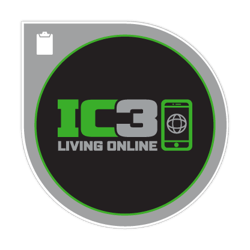
- Common functionality
- Email clients
- Calendaring
- Social media
- Communications
- Online conferencing
- Streaming
- Digital principles/ethics/skills/citizenship
When a student passes this exam, they will receive the IC3 Living Online digital badge.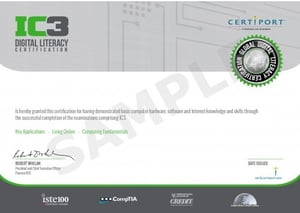
Once a student passes all three IC3 GS5 exams, they will receive the full IC3 GS5 Digital Literacy certification and the all-encompassing digital badge.
With all of that said about IC3 Spark and IC3 GS5, there’s still one last question to answer.
Which option is best for you and your students?
Which IC3 Certification Is Right for You and Your Students?

With all of this information about IC3 Spark and IC3 GS5, how are you supposed to decide which one to invest in?
Ultimately, only you know what would work best for your students. Here are a few points to consider when deciding.
The IC3 Spark Certification is perfect for a middle school teacher with students who aren’t very familiar with computers, digital literacy, and other related concepts.
The IC3 GS5 Certification is more appropriate for high school students who need to learn more in-depth skills and concepts related to digital literacy.
Where to Go from Here with Digital Literacy Education
If you end up choosing either one of these digital literacy certifications for your classes, you have a lot of work to do!
While most teachers will lean toward purchasing the IC3 test prep material, there’s so much more to preparing your students than that.
You need to embrace digital literacy as a crucial part of your curriculum!
Click below to learn more about teaching digital literacy in your classroom:


